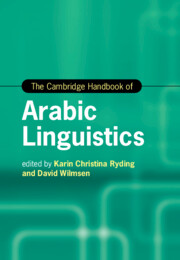Book contents
- The Cambridge Handbook of Arabic Linguistics
- Cambridge Handbooks in Language and Linguistics
- The Cambridge Handbook of Arabic Linguistics
- Copyright page
- Contents
- Figures
- Tables
- Notes on Contributors
- Acknowledgements
- Abbreviations
- Introduction
- Part I Arabic Applied Linguistics
- 1 Arabic Applied Linguistics
- 2 Language Planning in the Arab World in an Age of Anxiety
- 3 The Study of Arabic Language Acquisition
- 4 Issues in Arabic Language Testing and Assessment
- 5 Arabic Study Abroad
- 6 Models of Arabic Pronunciation
- Part II Arabic Variation and Sociolinguistics
- Part III Theoretical and Descriptive Studies
- Part IV Arabic Computational and Corpus Linguistics
- Part V Arabic Linguistics and New Media Studies
- Part VI Arabic Linguistics in Literature and Translation
- Index
- References
2 - Language Planning in the Arab World in an Age of Anxiety
from Part I - Arabic Applied Linguistics
Published online by Cambridge University Press: 23 September 2021
- The Cambridge Handbook of Arabic Linguistics
- Cambridge Handbooks in Language and Linguistics
- The Cambridge Handbook of Arabic Linguistics
- Copyright page
- Contents
- Figures
- Tables
- Notes on Contributors
- Acknowledgements
- Abbreviations
- Introduction
- Part I Arabic Applied Linguistics
- 1 Arabic Applied Linguistics
- 2 Language Planning in the Arab World in an Age of Anxiety
- 3 The Study of Arabic Language Acquisition
- 4 Issues in Arabic Language Testing and Assessment
- 5 Arabic Study Abroad
- 6 Models of Arabic Pronunciation
- Part II Arabic Variation and Sociolinguistics
- Part III Theoretical and Descriptive Studies
- Part IV Arabic Computational and Corpus Linguistics
- Part V Arabic Linguistics and New Media Studies
- Part VI Arabic Linguistics in Literature and Translation
- Index
- References
Summary
Tackling a knotty but crucial issue, Hussein Elkhafaifi examines deep-seated and protracted challenges of language planning in the Arab world. The long legacy of variation and language shift in spoken Arabic has led not only to the evolution of fixed boundaries between vernacular and written Arabic, but also to vigorous attempts to monitor, control, and update the written language, especially its lexical resources. Academies dedicated to strengthening and extending the lexicon of Modern Standard Arabic have existed for a century or more in several Arab countries, but have faced problems in dealing with modernization and expansion, challenged not only by the vigorous thriving of vernacular Arabic, but also by competition from Western languages such as English and French, especially in higher education, where wholesale borrowing of terms seems to continue unabated.
- Type
- Chapter
- Information
- The Cambridge Handbook of Arabic Linguistics , pp. 32 - 47Publisher: Cambridge University PressPrint publication year: 2021



